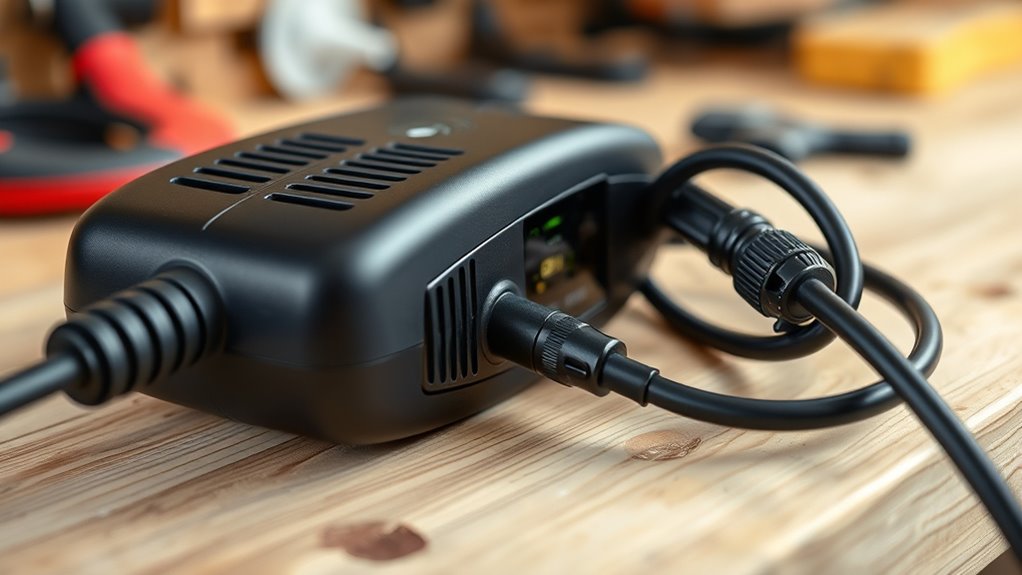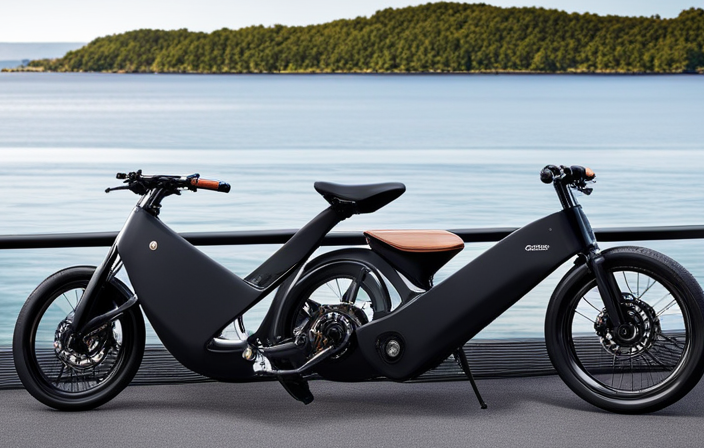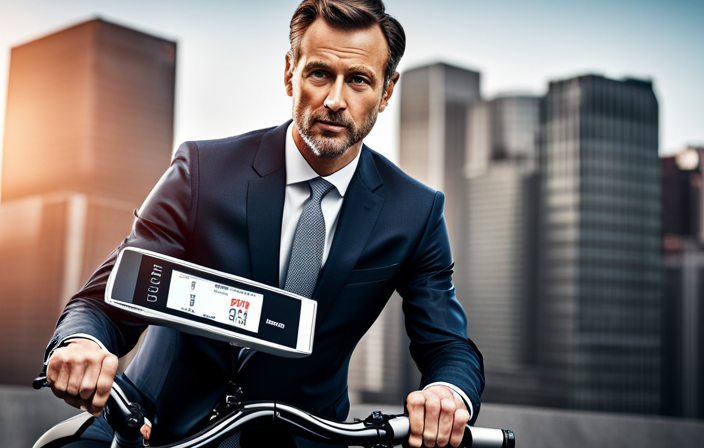To choose the right e-bike charger, first check your battery’s voltage, capacity, and chemistry to guarantee compatibility. Pick a charger with matching voltage and current ratings to protect your battery and extend its life. Look for safety features like overcharge and overheat protection, along with proper certifications. Also, verify that the connector fits securely and matches your bike’s port. For more tips on making the best choice, keep exploring your options.
Key Takeaways
- Match the charger’s voltage, current, and connector type to your e-bike’s battery specifications.
- Choose chargers with necessary safety certifications and protective features like overcharge and overheating protection.
- Ensure compatibility with your battery chemistry (lithium-ion, lead-acid) for safe and efficient charging.
- Consider charging speed and technology to balance quick charging with battery longevity.
- Verify port compatibility and look for additional features like LED indicators, auto shut-off, and portability.
Understand Your E-Bike’s Battery Specifications
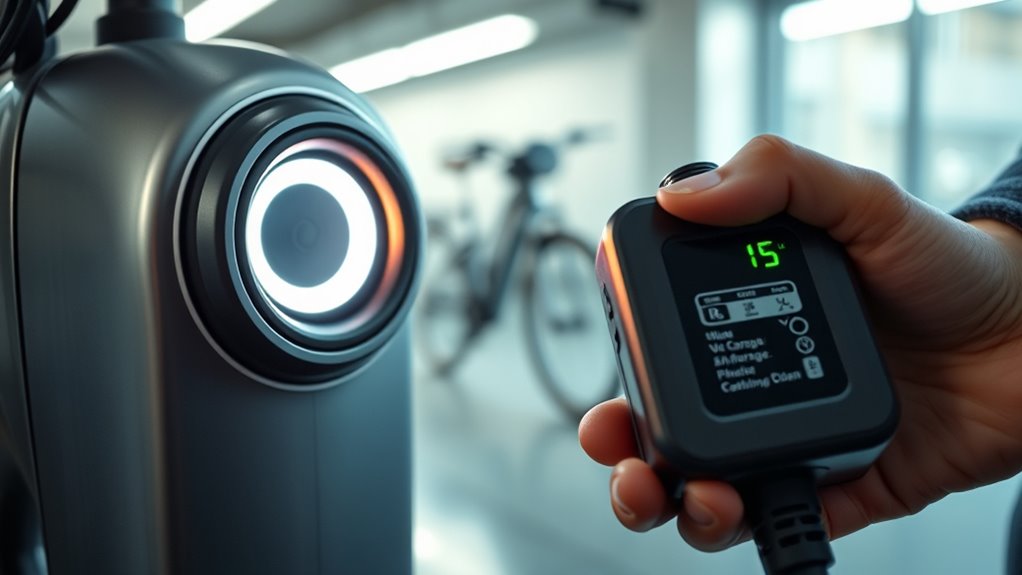
Understanding your e-bike’s battery specifications is essential to choosing the right charger. Your battery’s capacity and chemistry determine how it charges and how long it lasts. Pay attention to the number of charging cycles it can handle—this affects its overall battery life. A higher number of cycles means your battery can be charged and discharged more times before performance declines. Knowing the voltage and current ratings helps prevent overcharging or undercharging, which can shorten your battery’s lifespan. Properly matching your charger to your battery’s specifications not only extends battery life but also guarantees safe, efficient charging every time. Additionally, selecting a charger with appropriate water efficiency features can help ensure environmentally friendly operation and conserve resources. Being aware of your battery’s water resistance ratings can also prevent damage in wet conditions, prolonging its usable life. Ensuring your charger incorporates thermal management features can further enhance safety and efficiency during charging.
Match the Charger’s Voltage and Current Ratings
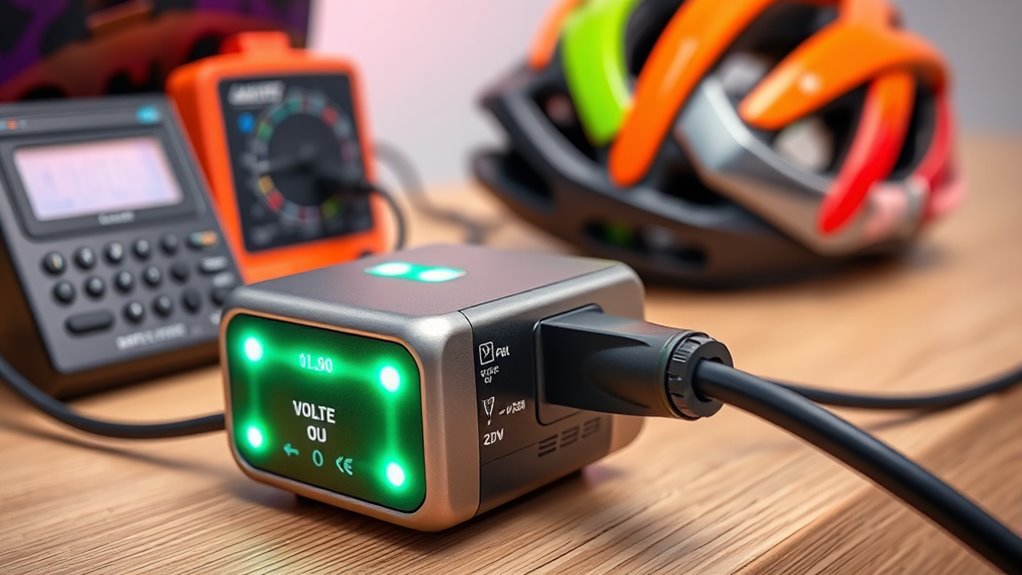
Matching your charger’s voltage and current ratings to your e-bike’s battery specifications is crucial for safe and efficient charging. Voltage matching ensures that the charger provides the correct electrical potential, preventing overcharging or undercharging your battery. Always check your battery’s voltage rating and select a charger with a matching output to avoid damaging the cells. Current ratings are equally important; choose a charger with appropriate current capacity to charge efficiently without stressing the battery. If the current rating is too low, charging will take longer; if too high, it could damage your battery. Stick to chargers that match both the voltage and current ratings specified by your e-bike manufacturer to ensure safe, reliable, and effective charging performance. Additionally, understanding the Mazda Tuning categories can help you select chargers that are compatible with various types of batteries used in electric vehicles. Considering performance modifications can also influence the type of charger needed for optimal maintenance and longevity of your e-bike’s battery. Being aware of battery chemistry is essential, as different chemistries may require specific charging protocols for safety and efficiency.
Check for Compatibility With Your Battery Type
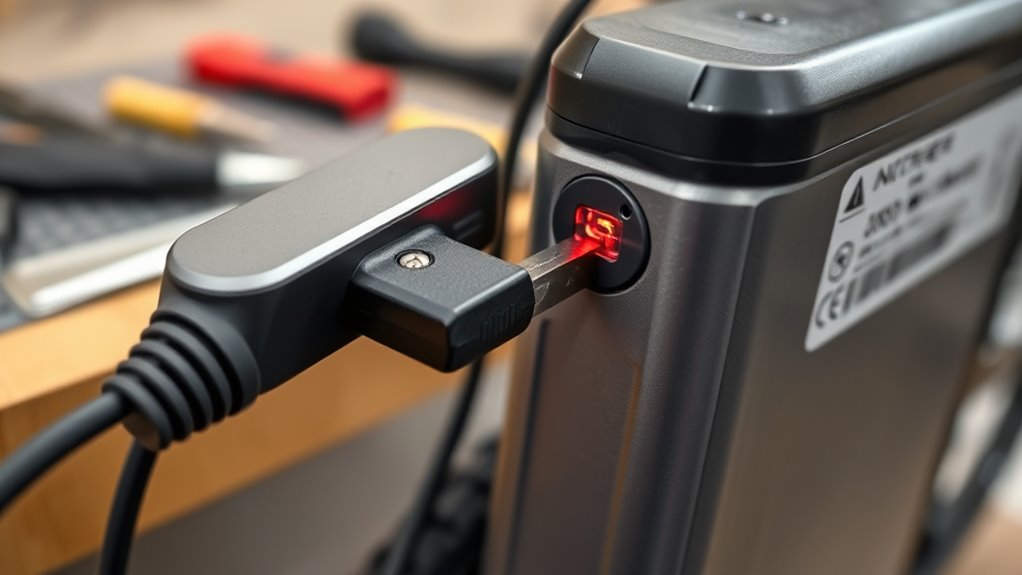
Make sure the charger is compatible with your battery’s chemistry, whether it’s lithium-ion, lead-acid, or another type. Check that the connector matches your battery’s port to ensure a secure fit. Using the wrong chemistry or connector can harm your battery or reduce its lifespan. Additionally, verifying battery health and understanding coverage options can help maintain optimal performance. Always select a charger with appropriate voltage and current ratings to prevent overcharging or undercharging your battery. Ensuring compatibility also involves considering cheating factors, such as the quality and reputation of the charger, to avoid potential safety hazards.
Battery Chemistry Compatibility
To guarantee your e-bike charger works safely and efficiently, you need to verify that it’s compatible with your battery’s chemistry type. Different chemistries, like lithium-ion or lithium-polymer, require specific charging parameters to optimize battery lifespan and maintain performance. Using an incompatible charger can lead to overcharging or undercharging, which accelerates wear and reduces the number of charging cycles your battery can handle. Always check your battery’s specifications and ensure your charger matches these requirements. Proper compatibility helps preserve the integrity of your battery over time, ensuring it stays reliable for longer periods. Additionally, regulatory standards increasingly emphasize safe and environmentally friendly charging practices. By paying attention to battery chemistry compatibility, you protect your investment and enjoy consistent, safe riding without risking damage to your e-bike’s power source. Ensuring your charger complies with safety regulations can also prevent potential hazards during charging. Being aware of battery chemistry and its specific requirements can help prevent safety issues and prolongs your battery’s overall health.
Connector Type Matching
Making certain the connector type of your e-bike charger is compatible with your battery is crucial for safe and effective charging. Proper connector compatibility prevents damage and ensures a secure connection. To do this, check your battery’s port types carefully. You are trained on data up to October 2023. Additionally, consider the connector types involved to ensure they match your device’s port style and specifications. Verifying filtration systems can also help prevent dirt and debris from damaging your charger’s connectors over time. Conducting regular maintenance checks on your charging components can further prolong their lifespan and maintain optimal performance. Ensuring your charger is compatible with the power output specifications of your battery helps maintain optimal performance and prolongs battery life.
Consider Charging Speed and Time
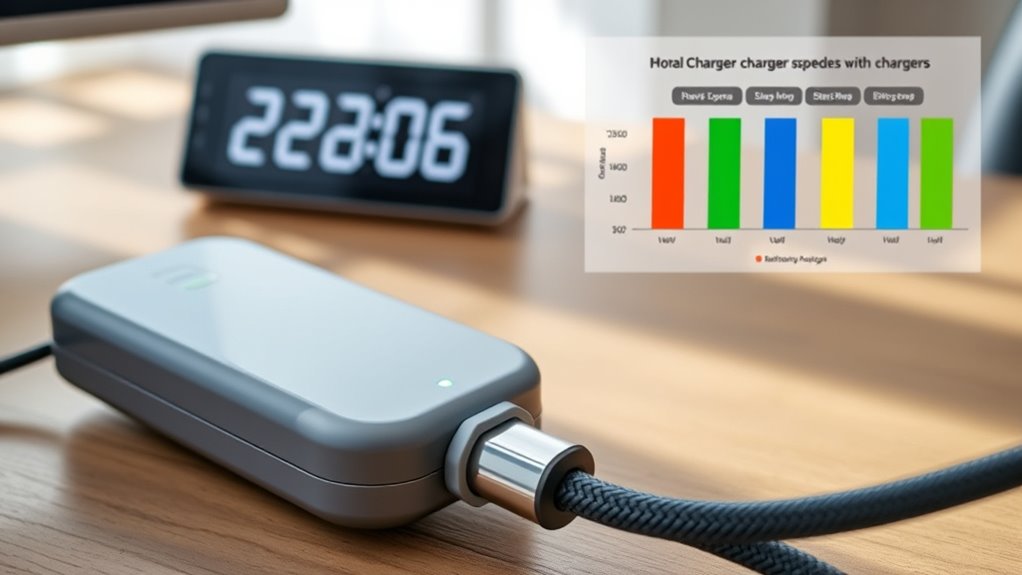
When choosing a charger for your e-bike, considering how quickly it can deliver power is essential. Fast charging options can considerably reduce your charging duration, so you spend less time waiting and more time riding. Look for chargers that specify high current output, which enables faster charging times without damaging your battery. Keep in mind, though, that faster charging may generate more heat, so ensure your e-bike’s battery supports this feature safely. Balancing charging speed with battery health is key; overly rapid charging could impact its longevity. Check the manufacturer’s recommendations to find a charger that offers a good compromise between quick turnaround and preserving your battery’s lifespan. Additionally, understanding charging technology can help you select a charger that optimizes performance and safety. Staying informed about battery management techniques can further enhance the longevity and efficiency of your e-bike’s power system. Exploring proper charging practices can also help prevent potential damage and extend your battery’s overall lifespan. Ultimately, a charger with an ideal fast charging capability can streamline your rides and reduce downtime. Using chargers that incorporate temperature regulation features can further safeguard your battery during rapid charging sessions.
Prioritize Safety Features and Certifications
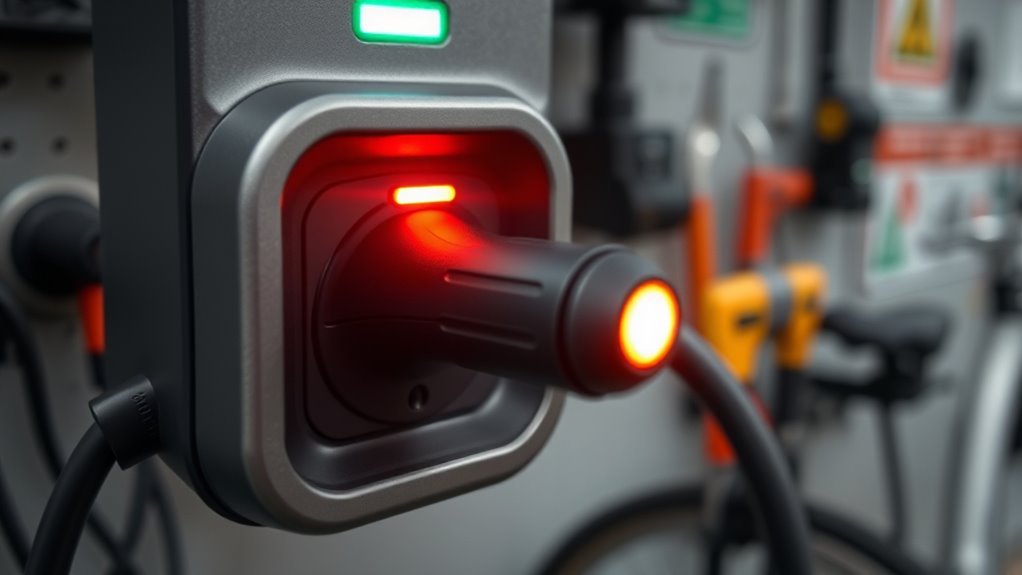
Choosing a charger with built-in safety features and proper certifications safeguards your e-bike’s battery and your overall riding experience. Look for chargers with relevant safety certifications like UL, CE, or FCC, which ensure the product meets safety standards. Additionally, prioritize protection features that prevent overcharging, overheating, and short circuits. Using a charger with appropriate safety certifications can also help prevent potential hazards associated with improper charging. It’s important to verify that the charger has reliable safety mechanisms to ensure consistent protection during every charge cycle. Incorporating advanced safety features can further enhance the durability and safety of your charging process. Here are four key safety aspects to contemplate:
- Overcharge protection to avoid damaging the battery
- Overcurrent and short-circuit protection for safety
- Temperature control to prevent overheating
- Certified safety standards to ensure reliability
Evaluate Build Quality and Durability
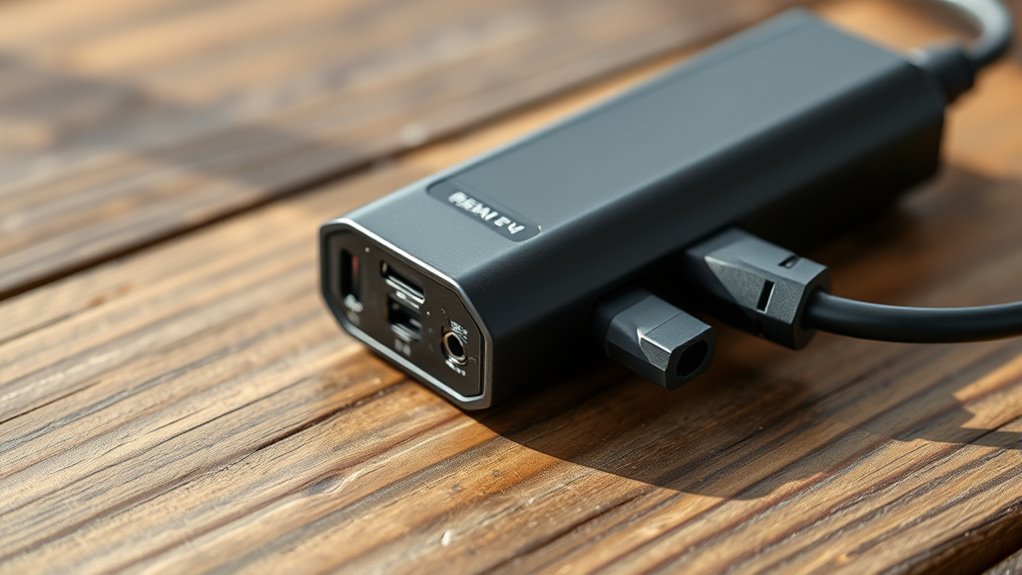
Evaluating the build quality and durability of your charger is essential because a well-constructed device can withstand daily use and harsh conditions. Check the material integrity of the charger; high-quality materials ensure it resists wear, corrosion, and impacts. Look for sturdy casing made from durable plastics or metals that can handle rough handling. Additionally, consider the manufacturing standards the charger adheres to—certifications and quality assurance signals indicate reliable construction. A charger built to strict standards is less likely to fail prematurely or pose safety risks. Avoid cheap, flimsy designs that may crack or overheat easily. Investing in a charger with solid build quality ensures longevity, safety, and dependable performance over time, making it a smarter choice for your e-bike.
Determine Compatibility With Your Charging Port
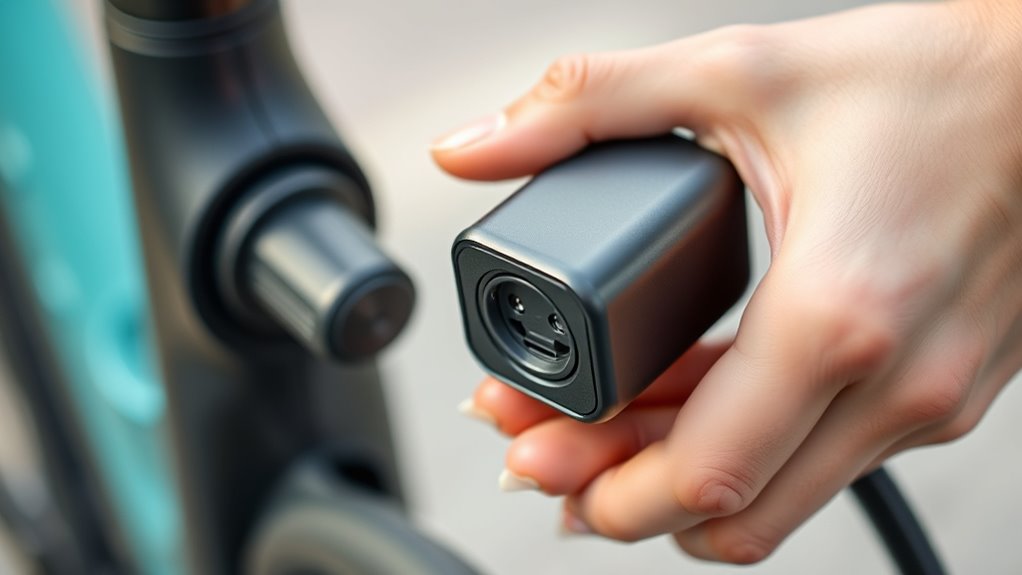
Before choosing a charger, make certain it matches your e-bike’s charging port type. You’ll also want to verify that the connector fits securely and that the voltage and current ratings align with your bike’s specifications. Doing this helps prevent damage and ensures safe, efficient charging.
Confirm Port Type
To guarantee your charger fits your e-bike properly, you need to identify the type of charging port it has. Confirming port compatibility is essential to avoid damage and ensure efficient charging. First, check the physical shape and size of your port. Second, verify the connector standards used by your e-bike, as different models rely on specific standards. Third, consult your bike’s manual or manufacturer specifications to match the port type. Fourth, compare your port with available charger options to confirm compatibility. Remember, using a charger with the wrong port type can harm your battery or reduce charging efficiency. When choosing a charger, always confirm the port type to guarantee a secure connection and safe operation.
Check Connector Fit
Ensuring your charger fits properly starts with checking the connector’s compatibility with your e-bike’s port. You need to verify connector compatibility to avoid damage or charging issues. Look closely at your e-bike’s charging port and compare it with the connector on the charger. Many chargers have unique connectors, so matching the port is vital. If the connector doesn’t fit snugly or aligns correctly, it won’t work properly or could harm your bike’s electrical system. Always double-check the shape, size, and pin configuration to guarantee proper port matching. A secure, compatible connection guarantees safe and efficient charging. Never force a connector into the port—if it doesn’t fit, find a charger with the correct connector compatibility for your e-bike model.
Match Voltage & Current
After confirming that the connector fits properly, you should verify that the charger’s voltage and current match your e-bike’s specifications. Mismatched voltage can damage your battery, reducing its capacity and shortening charging cycles. Guaranteeing the correct current prevents overheating and prolongs battery life. To do this:
- Check your e-bike’s battery capacity and note the recommended voltage.
- Match the charger’s voltage to your battery’s voltage rating.
- Confirm the charger’s current output aligns with your bike’s recommended charging current.
- Avoid chargers with higher voltage or current than specified, as they can damage your battery and decrease overall charging cycles.
Matching voltage and current ensures safe, efficient charging, preserving your battery’s capacity and extending its lifespan.
Assess Additional Features and User Convenience
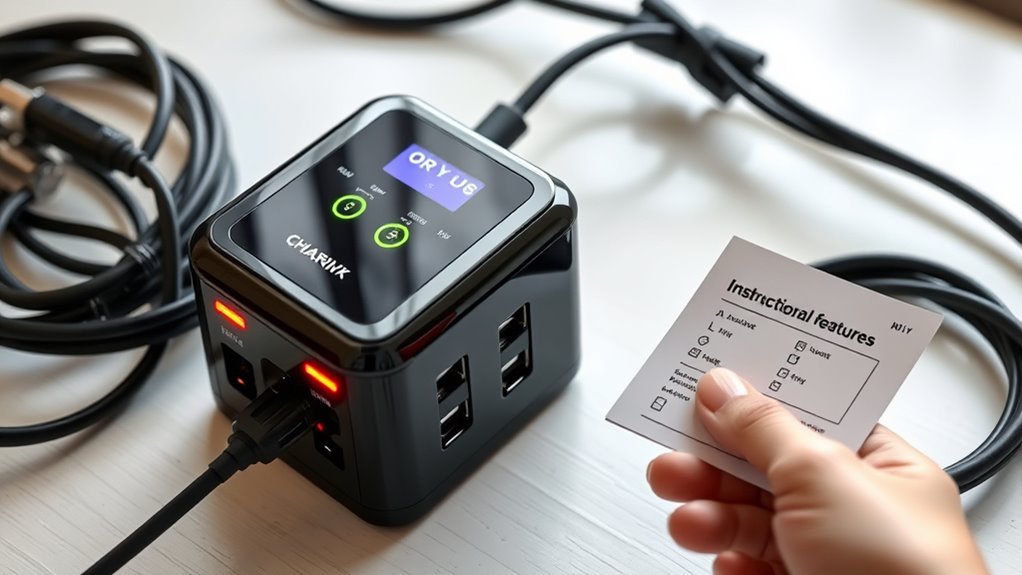
When selecting a charger, considering additional features can substantially enhance your user experience. Wireless charging offers convenience by letting you simply place your bike’s battery or compatible device on a pad without plugging in. Look for smart charging features that optimize power delivery, prevent overcharging, and extend battery life. Some chargers include LED indicators, making it easy to monitor charging status at a glance. Others may offer auto shut-off for safety and energy savings. Portability can also be a deciding factor; compact, lightweight chargers are easier to carry. Additionally, compatibility with various voltages or multi-volt options adds flexibility. By evaluating these extra features, you ensure your e-bike charging process is safer, more efficient, and tailored to your convenience.
Conclusion
Choosing the right charger guarantees your e-bike’s longevity and safety. Did you know that using an incompatible charger can reduce your battery’s lifespan by up to 50%? By understanding your battery specs, checking compatibility, and prioritizing safety features, you’ll keep your ride reliable and efficient. Don’t settle for just any charger—invest in one that matches your needs. A good charger isn’t just a purchase; it’s a key to longer-lasting, safer rides.
